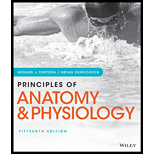
List the names and chemical symbols of the 12 most abundant chemical elements in the human body.
To review:
The names and chemical symbols of the 12 most abundant chemical elements in the human body.
Introduction:
Generally, human body is made up of 26 different chemical elements. Ninety-six percent of the body weight is due to four major elements: oxygen, carbon, hydrogen, and nitrogen. The next eight elements, for example, calcium, phosphorus, magnesium, sodium, potassium, chlorine, sulfur, and iron, are macronutrients and are considered as lesser elements. The rest of the 14 elements that are present in minute amounts are considered as trace elements, like aluminum (Al), fluorine (F), tin (Sn), etc.
Explanation of Solution
Human body is comprised of different types of chemical elements, out of which 12 are the most important. These are as follows:
| Chemical elements with symbols | Total percentage of chemical elements present in the body |
| Oxygen (O) | 65 |
| Carbon (C) | 18.5 |
| Hydrogen (H) | 9.5 |
| Nitrogen (N) | 3.2 |
| Calcium (Ca) | 1.5 |
| Phosphorus (P) | 1.0 |
| Potassium (K) | 0.35 |
| Sulfur (S) | 0.25 |
| Sodium (Na) | 0.2 |
| Chlorine (Cl) | 0.2 |
| Magnesium (Mg) | 0.1 |
| Iron (Fe) | 0.005 |
The human body has more oxygen by mass than any other element due to the water content present in the body, but more hydrogen is present by atom fraction than any other element.
Want to see more full solutions like this?
Chapter 2 Solutions
Principles of Anatomy and Physiology
- Noggin mutation: The mouse, one of the phenotypic consequences of Noggin mutationis mispatterning of the spinal cord, in the posterior region of the mouse embryo, suchthat in the hindlimb region the more ventral fates are lost, and the dorsal Pax3 domain isexpanded. (this experiment is not in the lectures).a. Hypothesis for why: What would be your hypothesis for why the ventral fatesare lost and dorsal fates expanded? Include in your answer the words notochord,BMP, SHH and either (or both of) surface ectoderm or lateral plate mesodermarrow_forwardNot part of a graded assignment, from a past midtermarrow_forwardNot part of a graded assignment, from a past midtermarrow_forward
- please helparrow_forwardWhat does the heavy dark line along collecting duct tell us about water reabsorption in this individual at this time? What does the heavy dark line along collecting duct tell us about ADH secretion in this individual at this time?arrow_forwardBiology grade 10 study guidearrow_forward
 Principles Of Radiographic Imaging: An Art And A ...Health & NutritionISBN:9781337711067Author:Richard R. Carlton, Arlene M. Adler, Vesna BalacPublisher:Cengage Learning
Principles Of Radiographic Imaging: An Art And A ...Health & NutritionISBN:9781337711067Author:Richard R. Carlton, Arlene M. Adler, Vesna BalacPublisher:Cengage Learning Biology Today and Tomorrow without Physiology (Mi...BiologyISBN:9781305117396Author:Cecie Starr, Christine Evers, Lisa StarrPublisher:Cengage Learning
Biology Today and Tomorrow without Physiology (Mi...BiologyISBN:9781305117396Author:Cecie Starr, Christine Evers, Lisa StarrPublisher:Cengage Learning Human Biology (MindTap Course List)BiologyISBN:9781305112100Author:Cecie Starr, Beverly McMillanPublisher:Cengage Learning
Human Biology (MindTap Course List)BiologyISBN:9781305112100Author:Cecie Starr, Beverly McMillanPublisher:Cengage Learning Biology (MindTap Course List)BiologyISBN:9781337392938Author:Eldra Solomon, Charles Martin, Diana W. Martin, Linda R. BergPublisher:Cengage Learning
Biology (MindTap Course List)BiologyISBN:9781337392938Author:Eldra Solomon, Charles Martin, Diana W. Martin, Linda R. BergPublisher:Cengage Learning





